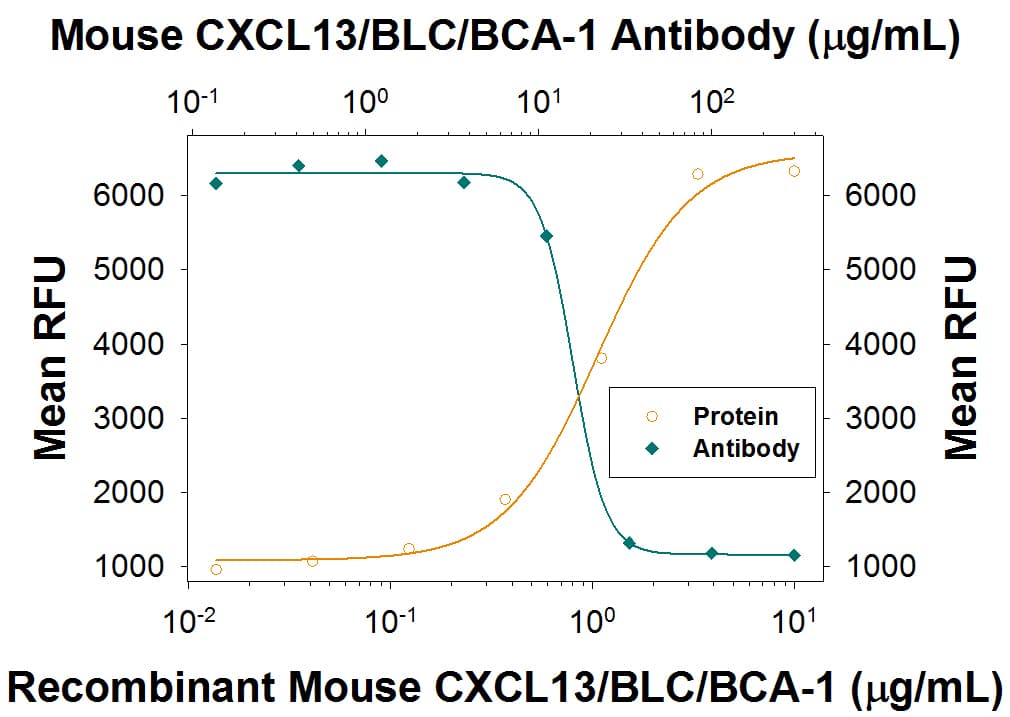

 下载产品说明书
下载产品说明书 下载SDS
下载SDS 用小程序,查商品更便捷
用小程序,查商品更便捷



 收藏
收藏
 对比
对比 咨询
咨询



Ile22-Ala109
Accession # O55038


Scientific Data
 View Larger
View LargerChemotaxis Induced by CXCL13/BLC/BCA-1 and Neutralization by Mouse CXCL13/BLC/BCA-1 Antibody Recombinant Mouse CXCL13/BLC/BCA-1 (Catalog # 470-BC) chemoattracts the BaF3 mouse pro-B cell line transfected with human CXCR5 in a dose-dependent manner (orange line). The amount of cells that migrated through to the lower chemotaxis chamber was measured by Resazurin (Catalog # AR002). Chemotaxis elicited by Recombinant Mouse CXCL13/BLC/BCA-1 (4 µg/mL) is neutralized (green line) by increasing concentrations of Recombinant Mouse CXCL13/BLC/BCA-1 Monoclonal Antibody (Catalog # MAB470R). The ND50 is typically 12-30 µg/mL.
Mouse CXCL13/BLC/BCA-1 Antibody Summary
Ile22-Ala109
Accession # O55038
Applications
Mouse CXCL13/BLC/BCA-1 Sandwich Immunoassay
Please Note: Optimal dilutions should be determined by each laboratory for each application. General Protocols are available in the Technical Information section on our website.


Background: CXCL13/BLC/BCA-1
CXCL13, also known as B-lymphocyte chemoattractant (BLC) and BCA-1, is a CXC chemokine that is constitutively expressed in secondary lymphoid organs. Mouse CXCL13 cDNA encodes a precursor protein of 109 amino acid residues with a putative leader sequence of 21 residues. Mature mouse CXCL13 shares 64% amino acid sequence similarity with the human protein and 23-34% amino acid sequence identity with other known CXC chemokines. Recombinant or chemically synthesized CXCL13 is a potent chemoattractant for B lymphocytes but not T lymphocytes, monocytes or neutrophils. BLR1, a G protein-coupled receptor originally isolated from Burkitt’s lymphoma cells, has now been shown to be the specific receptor for CXCL13. Among cells of the hematopoietic lineages, the expression of BLR1, now designated CXCR5, is restricted to B lymphocytes and a subpopulation of T helper memory cells. Mice lacking BLR1 have been shown to lack inguinal lymph nodes. These mice were also found to have impaired development of Peyer’s patches and defective formation of primary follicles and germinal centers in the spleen as a result of the inability of B lymphocytes to migrate into B cell areas.
- Gunn, M.D. et al. (1998) Nature, 391:799.
- Legler, D.F. et al. (1998) J. Exp. Med. 187:655.
- Forster, R. et al. (1996) Cell 87:1037.

Preparation and Storage
- 12 months from date of receipt, -20 to -70 °C as supplied.
- 1 month, 2 to 8 °C under sterile conditions after reconstitution.
- 6 months, -20 to -70 °C under sterile conditions after reconstitution.
参考图片
Chemotaxis Induced by CXCL13/BLC/BCA-1 and Neutralization by Mouse CXCL13/BLC/BCA-1 Antibody Recombinant Mouse CXCL13/BLC/BCA-1 (Catalog # 470-BC) chemoattracts the BaF3 mouse pro-B cell line transfected with human CXCR5 in a dose-dependent manner (orange line). The amount of cells that migrated through to the lower chemotaxis chamber was measured by Resazurin (Catalog # AR002). Chemotaxis elicited by Recombinant Mouse CXCL13/BLC/BCA-1 (4 μg/mL) is neutralized (green line) by increasing concentrations of Recombinant Mouse CXCL13/BLC/BCA-1 Monoclonal Antibody (Catalog # MAB470R). The ND50 is typically
12-30 μg/mL.







 危险品化学品经营许可证(不带存储) 许可证编号:沪(杨)应急管危经许[2022]202944(QY)
危险品化学品经营许可证(不带存储) 许可证编号:沪(杨)应急管危经许[2022]202944(QY)  营业执照(三证合一)
营业执照(三证合一)